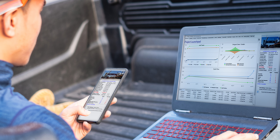Revolutionizing Construction Management: The Power of Mobile-Enabled, Cloud-Based ERP Software
How Cloud-Based ERP Software is Transforming Construction Management
Technology is rapidly reshaping construction management. Traditional paper-based systems and in-house software solutions are evolving to new ERP (Enterprise Resource Planning) systems that allow more efficient distribution of information and better collaboration among project teams. New mobile-enabled, cloud-based construction management software helps companies be more productive by managing and tracking project information faster and distributing data to mobile devices so any member of the team can 2easily access the information they need. This technology allows real time updates at the construction site, enhanced data security, as well as powerful reporting and analytics.
These technologies empower construction companies to build better, smarter, and more efficiently. We will explore the future of construction management and show how utilizing these innovative technologies can make your company more productive overall.
ERP Software Helps Construction Companies Manage Projects Better
ERP software is a big driver of success in the construction industry because it’s an integrated system for handling the complexities of building projects. It helps improve collaboration and streamline processes so construction companies can work more productively.
Here are five key ways ERP software helps enhance construction management.
- Streamlined Project Management – With a single centralized source of data for all project information, including budgets, schedules, and materials inventory, ERP software provides a comprehensive, integrated view of the entire project.
- Cost Control — Tracking expenses and identifying budget overruns is the foundation of a successful construction company.
- Document Management — It’s no secret that construction is a document heavy industry. Using ERP software to track and manage plans, specifications, drawings, change orders and more helps reduce paperwork, improve version control, and support better collaboration.
- Supply Chain Management — Minimizing delays plays a huge part in successful project completion. ERP software helps track material orders, deliveries, and inventory levels so project materials will be available when needed.
- Reporting and Analytics – ERP software provide powerful reporting and analytics tools, so that construction companies can track KPIs, analyze and understand historical data, and provide up to date information for decision-making.
ERP software helps construction companies manage projects more efficiently, control costs, and optimize resources. This makes ERP software a big competitive advantage in a rapidly changing industry.

Cloud ERP Software in Construction Management is Flexible and Job Site Ready
Construction is done from various project sites. The majority of workers in construction do not have easy access to desktop computer and applications, but cloud-based ERP software for construction management is ideal for use in the field.
Designed with greater flexibility and simplicity, cloud-based construction ERP systems are better suited for work on job sites. Features such as touch screen controls, faster loading times, and brighter colors to represent key data allow the information to be displayed and presented more effectively on mobile devices.
For example: site managers equipped with mobile devices can capture and instantly share photos, videos, and notes about ongoing construction activities. This real-time data helps project managers and others make informed decisions, track progress more accurately, and resolve issues promptly.
Improve Collaboration
Cloud-based systems support remote collaboration among key stakeholders like architects, engineers, subcontractors, and clients. The ability to access project documents, 3D models, and schedules from anywhere helps streamline complex processes and improve decision-making.
Moreover, mobile friendly ERP systems streamline construction management processes like AP approval, invoice submittals, field labor time capture, scheduling and approvals, time & materials billing, and equipment management.
Secure Data Storage
Cloud construction ERP systems use robust security measures like encryption, access controls, and multi-factor authentication to keep sensitive project data safe. These security features are often more extensive and updated more regularly than most on-premises solutions.
Data stored in the cloud is automatically backed up and replicated across multiple servers in different geographic locations. This redundancy reduces the risk of data loss due to hardware failures, natural disasters, or human errors.
Scalable and Flexible
As a construction company grows or takes on larger projects, cloud-based ERP software can seamlessly scale to accommodate increased users, data, and resources. There’s no need to invest in costly hardware upgrades or reconfiguration because the system is managed by the software provider.
Cloud ERP solutions in construction often offer customization options to tailor the software to specific project needs or company workflows. This adaptability allows construction firms to optimize processes for their specific needs and maintain a competitive edge.
Cost Efficiency
By eliminating the need for on-premises servers, data centers, and associated maintenance, construction companies can significantly reduce IT infrastructure expenses. This frees up capital for other critical investments.
Certain cloud ERP providers offer flexible pricing models where construction firms only pay for the features and resources they use. This pay-as-you-go approach eliminates large upfront costs and ensures cost efficiency.
Real-time Reporting and Analytics
Project managers can access up-to-the-minute project metrics, including budget tracking, schedules, resource allocation, and materials inventory. The ability to view data in real time provides opportunities to correct any issues before they become large enough to damage the project.
Using historical project data stored in the cloud, construction companies can utilize predictive analytics to forecast potential project delays, cost overruns, and resource shortages. With the foresight that comes from years of data, it’s easier to understand project risks and create an accurate project plan.
Challenges and Considerations
While the advanced technology of cloud based ERP systems has multiple benefits for improving construction management, there are a few challenges that should be considered by construction companies.
Data Privacy and Compliance
Construction companies must be diligent in addressing data privacy and compliance concerns, especially when working with sensitive client information or operating in regions with strict data protection regulations. Ensuring compliance with GDPR, HIPAA, or other relevant standards is essential and may require additional security measures and documentation.
Internet Connectivity Issues
Construction sites in remote or poorly connected areas may face challenges with consistent internet access. To mitigate this issue, construction companies may need to invest in mobile hot spots, satellite internet, or offline-capable applications to ensure uninterrupted access to their cloud ERP systems.
User Training and Adoption
The successful implementation of cloud ERP software relies on user adoption. To help employees use these systems to their benefit, construction companies must allocate resources for comprehensive training programs to help employees become proficient. Resistance to change is a common challenge, so change management strategies should be employed to ease the transition.
Conclusion
Cloud-based construction ERP software allows construction companies to access real-time updates and collaborate remotely. It unlocks new levels of efficiency and productivity at construction sites. It empowers construction professionals to make informed decisions, manage resources effectively, and stay within budget constraints.
Enhanced data security and scalability, combined with cost efficiencies from pay as you go pricing, are changing how construction firms approach their IT infrastructure. Meanwhile, the predictive analytics and customization options offered by cloud ERP systems are paving the way for smarter, more effective project management.






